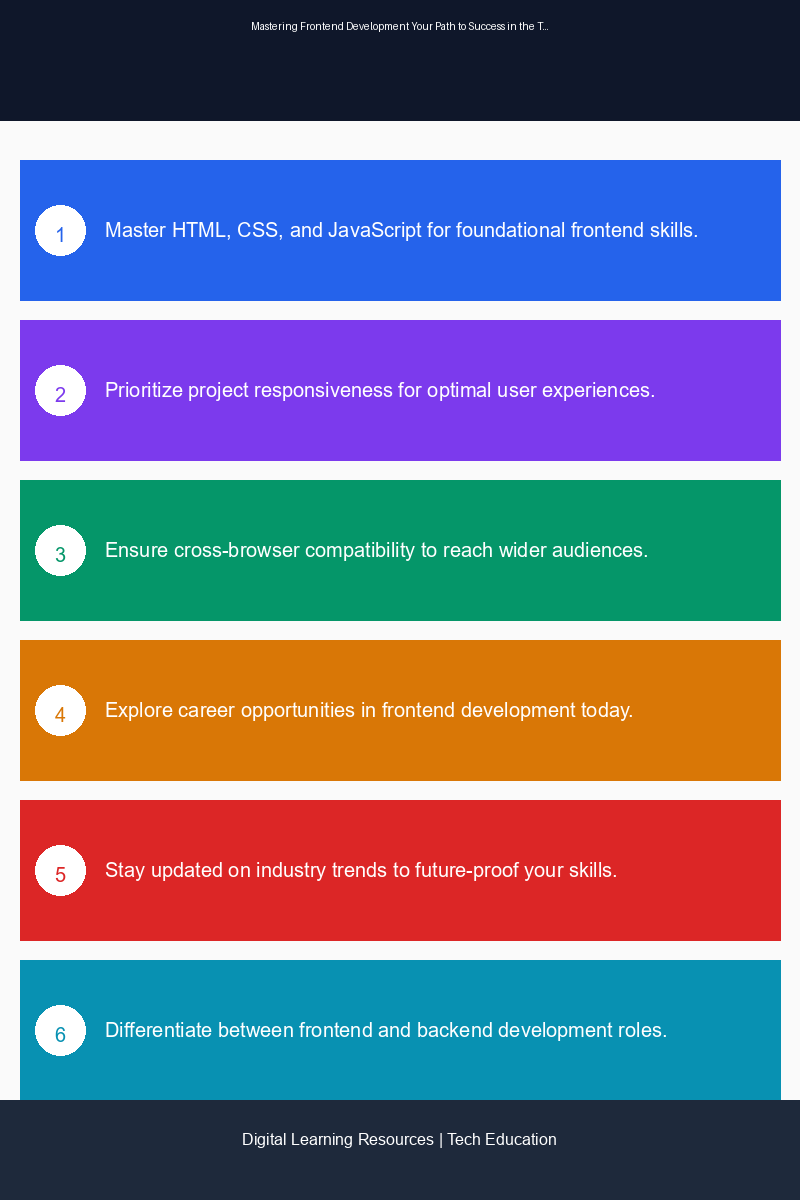As the digital landscape evolves, frontend development emerges as a critical domain for tech professionals. This blog post will explore the essential technical concepts of frontend development, outline effective learning paths, and highlight industry trends that shape career opportunities. Whether you are a seasoned developer or just starting your journey, this guide offers actionable insights and practical applications for mastering frontend development.
Key Takeaways
- Understanding the essentials of frontend vs. backend development.
- Mastering foundational technologies: HTML, CSS, and JavaScript.
- Emphasizing the importance of project responsiveness and cross-browser compatibility.
- Identifying career opportunities and preparing for the job market.
- Staying updated on industry trends and future skill requirements.
Technical Background and Context
Frontend development, often referred to as client-side development, focuses on the visible and interactive elements of websites and applications. This encompasses everything a user sees and interacts with, from layout and design to buttons and animations. The distinction between frontend and backend (server-side) development is crucial; while frontend developers craft user interfaces, backend developers manage the server, database, and application logic.
In today’s competitive landscape, the importance of project responsiveness and cross-browser compatibility cannot be overstated. Users expect seamless experiences across various devices and browsers. A responsive design ensures that web applications look good and function well on desktops, tablets, and smartphones, while cross-browser compatibility guarantees that these applications behave consistently regardless of the browser used.
📚 Recommended Digital Learning Resources
Take your skills to the next level with these curated digital products:
AI Enhanced Resume Builder
AI Resume Builder Flask App – Complete Source Code + PDF Tutorial + HTML | Digital Download for Designers
AWS Solutions Architect Associate SAA-C03 Complete Study Guide & Practice Exam Bundle
AWS Solutions Architect Associate SAA-C03 Complete Study Guide & Practice Exam Bundle
📊 Key Learning Points Infographic

Visual summary of key concepts and actionable insights
Learn AWS: Your First Cloud Application
Learn AWS: Your First Cloud Application
Comprehensive SAT Prep: 470+ Vocabulary Words
Comprehensive SAT Prep: 470+ Vocabulary Words
JavaScript for Web Development eBook | Learn to Build Interactive Websites
JavaScript for Web Development eBook | Learn to Build Interactive Websites
Practical Applications and Use Cases
Frontend development is not just about writing code; it’s about solving problems and creating engaging user experiences. Here are some practical applications:
- Single Page Applications (SPAs): Frameworks like React and Vue.js enable developers to build SPAs that load quickly and provide a smooth user experience.
- Responsive Web Design: Using CSS frameworks such as Bootstrap or Tailwind CSS, developers can create responsive layouts that adapt to different screen sizes.
- Interactive Features: Implementing JavaScript libraries like jQuery or utilizing vanilla JavaScript can enhance interactivity, such as creating dynamic forms or engaging animations.
Learning Path Recommendations
For aspiring frontend developers, a structured learning path can facilitate a smooth transition into the industry. Here’s a roadmap to guide your journey:
- Start with the Basics: Begin by mastering HTML for structuring web pages, CSS for visual styling, and JavaScript for interactivity.
- Intermediate Skills: Learn about responsive design principles, CSS preprocessors like SASS, and version control systems like Git.
- Advanced Technologies: Progress to frameworks and libraries such as React, Angular, or Vue.js. Familiarize yourself with performance optimization techniques and API integration.
- Prepare for the Job Market: Build a portfolio showcasing your projects, contribute to open-source initiatives, and network with other professionals in the field.
Industry Impact and Career Implications
The demand for skilled frontend developers is on the rise, with leading companies and startups continually seeking professionals who can create engaging user experiences. Organizations understand that effective frontend development is crucial for user engagement and ultimately drives business success. As a result, career opportunities in this domain are abundant, with roles ranging from frontend developer to UI/UX designer and beyond.
Implementation Tips and Best Practices
To excel in frontend development, consider the following implementation tips and best practices:
- Keep Learning: The tech industry is ever-evolving. Stay updated with the latest trends, technologies, and tools through online courses, webinars, and tech blogs.
- Focus on User Experience: Collaborate closely with UI/UX designers to ensure that web pages are not only functional but also user-friendly.
- Test Rigorously: Ensure cross-browser compatibility by testing your applications across various browsers. Utilize tools like BrowserStack or Sauce Labs for comprehensive testing.
- Optimize Performance: Minimize load times by optimizing images, reducing HTTP requests, and leveraging browser caching.
Future Trends and Skill Requirements
As technology continues to advance, several trends are shaping the future of frontend development:
- Progressive Web Apps (PWAs): PWAs combine the best of web and mobile apps, providing offline capabilities and improved performance.
- Server-Side Rendering (SSR): Frameworks like Next.js are gaining popularity for their ability to improve SEO and performance through SSR.
- Low-Code and No-Code Platforms: These platforms are emerging, enabling non-developers to create applications, which may shift the traditional role of frontend developers.
To stay relevant, frontend developers should focus on mastering both foundational skills and emerging technologies. Collaboration, adaptability, and continuous learning will be key to thriving in this dynamic environment.
Conclusion with Actionable Next Steps
Mastering frontend development is a rewarding journey that opens up numerous career opportunities. By understanding the technical concepts, following a structured learning path, and staying updated with industry trends, you can position yourself for success in this rapidly evolving field.
Here are some actionable next steps:
- Enroll in online courses specializing in frontend development.
- Start building your portfolio by creating personal projects or contributing to open-source.
- Join online communities or forums to network with other developers and share knowledge.
- Stay informed about industry trends by subscribing to tech newsletters and blogs.
Embark on your frontend development journey today, and unlock the potential for a fulfilling career in the tech industry!
Disclaimer: The information in this article has been gathered from various reputed sources in the public domain. While we strive for accuracy, readers are advised to verify information independently and consult with professionals for specific technical implementations.
Ready to advance your tech career? Explore our digital learning resources including programming guides, certification prep materials, and productivity tools designed by industry experts.



